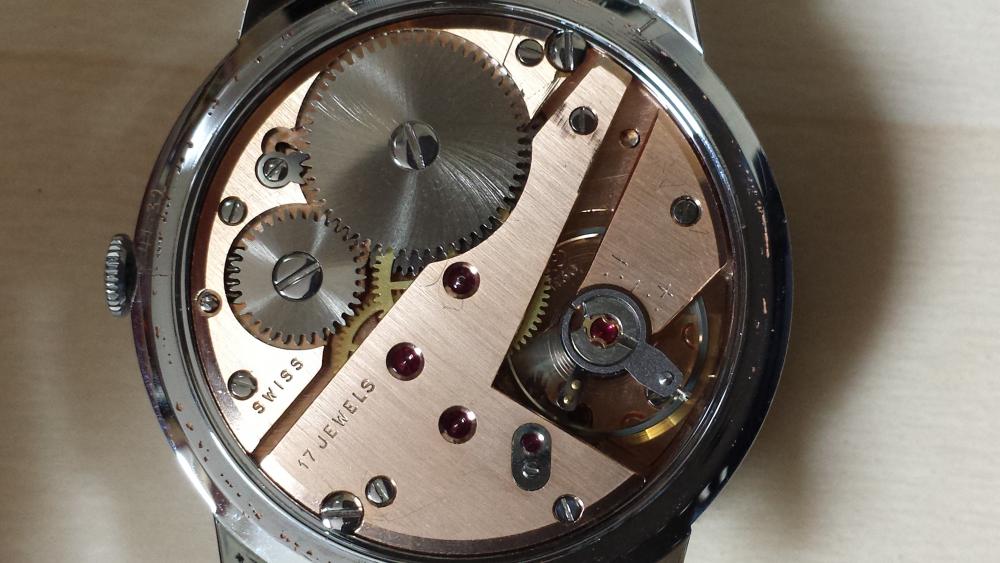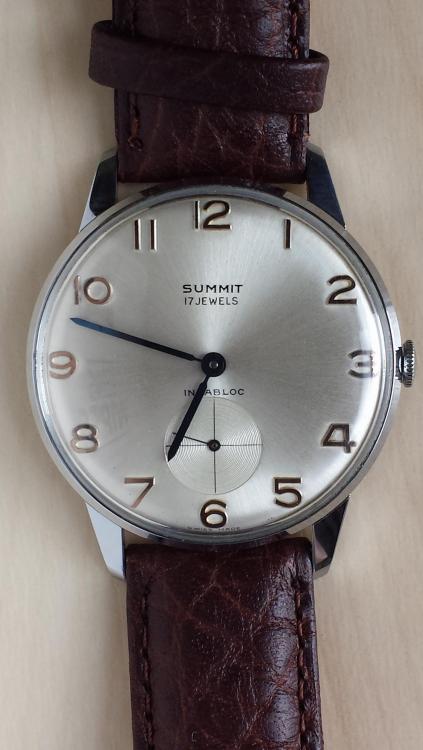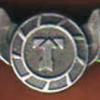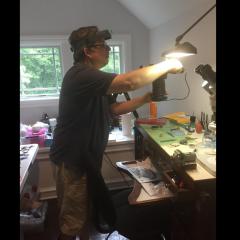Leaderboard
Popular Content
Showing content with the highest reputation on 07/09/16 in all areas
-
I recently completed work on the timepiece that actually got me interested in watchmaking. I purchased the movement (in pieces) for a vintage Omega Speedmaster a few months back and have been diligently working on putting it back together. It was a pricey endeavor but what I've learned from the experience is invaluable and having the watch ticking away in hand at the end of the project was reward enough. I picked up the movement in February and knew it was missing some parts. I counted the minute recording wheel and hour recording wheel as bits that were missing but also couldn't locate the minute recording pawl and pawl bridge. It turns out they were inside of the semi assembled movement but unfortunately I didn't realize that until I had already ordered replacements- oops! Included with the movement was the front case, hour, minute, and sweep second hands, and some spare parts the previous owner had acquired. He warned me that the watch hadn't worked properly before it was disassembled but I had confidence that I could sort it out. First thing I set to do was assemble as much of the movement as possible to determine what else was missing and what may be broken. It became apparent quickly that there were many screws gone! There weren't many parts missing other than those I've already noted but I did manage to lose the click spring when it shot away from my tweezers. I've since become more adept at dealing with wire springs and don't attack any of them without two hands. When breaking down the movement for cleaning I discovered that the chronograph blocking lever screw had been broken off in the plate. Extracting the remains of the screw from the plate was actually easier than procuring a replacement screw. I placed the plate in a solution of alum and warm water over night and the screw was eaten away. The steel posts and eccentrics in the plate I protected from the alum with silicon caulk which I later removed with a bit of pegwood. After cleaning, I began reassembling the watch but was stopped short when I discovered the mainspring barrel gear teeth were damaged. I replacement was ordered straight away. Now I was ready to assemble the movement. I made sure to inspect all jewels and pivots before putting the gear train together. And I was rewarded with an exceptionally well beating movement. This was a relief since I've spent more than enough time on my previous projects straightening hairsprings, truing balances, and correcting beat errors. Next the chronograph layer came together. This takes quite a while since there are so many bits to lubricate and test the motion of before moving on to the next bit. Also, with so many screws missing I had to stop several times to order replacements. Below is the movement prior to final adjustment. A screw is missing at the top and the chronograph bridge screw isn't correct but it gets the job done. I discovered that the previous owner had already procured the missing hour recording wheel so that saved me a bit trouble. And the dial side came together quickly. The hour recording wheel is turned directly by the barrel and the blocking lever wasn't set properly before I put the dial on so the hour recorder creeped which required me to go back and remove the dial and re-adjust the blocking lever. I'll remember the importance of that adjustment the next time I do a chronograph repair! I needed to purchase a replacement dial and a full set of hands as well. I could have reused the hour and minute hands that came with the movement but since they were scuffed and faded and wouldn't have matched the other four hands I sold them to pay for a whole new set. It's not something I regret though because with the new dial and hands the watch looks about good as new. The case I had was missing the caseback and pushers but I found a gentleman who was selling the case (with pushers) and caseback together so I purchased the lot. I also procured a replacement dust cover since that turned out to be missing as well. No point in doing a job unless it's done right I suppose. And there you go! I'm quite happy with the result here. It was expensive but I now have a complete and fully functioning Speedmaster. The chronograph worked without a hitch and the watch has kept impeccable time too. It took quite a long time to get this one together but the patience has really paid off. I really love working on chronograph movements and am hoping to do a Venus or Valjoux soon but my next project is a bit more eclectic- a Cinderella watch by US Time from the 1960's! This will be my first pin pallet service. (excitement!)3 points
-
I agree with oldhippy it is a real strange one. I just wonder if it was a clock that was made by an apprentice clockmaker/watchmaker but never finished.2 points
-
I found this Summit on ebay going for not much £ - just loved the look of it. The hands are beautifully blued. A clean+oil, new mainspring and strap, it's running well and looks great The movement is a 17J A Schild 1130, which would date it to 1955-60, but it looks more modern to me. Anyone heard of Summit ?2 points
-
Seiko uses graphite loaded lubricant (and you should also) there. That's the residue, perfectly normal.1 point
-
1 point
-
How nice to have all those memories of your father along with the things he had that was to do with his work. You must have already realized that watch/clockmakers or repairers never throw anything away. The amount of stuff I had It was incredible that I managed to find places to put it all. When I decided that I'd had enough I had to sort out the good from the bad, I had a skip to get rid of the real junk while the rest went to auction.1 point
-
1 point
-
Just a note..these type of barrels have the lid holding on to the barrel ( as opposed to the barrel holding the lid) . You need to ensure the lid comes off level, if you distort the edge it may not go back tightly enough. HTH Anil1 point
-
It's the same as with some Seiko barrels. Use a breakable knife to open them. Some little mark there always will be? But it works very nice? WD40 in watches is a killer? Welcome to the forum BTW1 point
-
1 point
-
I had a similar issue on an AS5008. I was discussing with a Rolex watchmaker at a recent lecture and he had a great suggestion. Take a regular razor blade and grind the edge to a taper. So you are forming the edge into a fine taper. Turn the barrel on edge and place on your bench - like a wheel on a car. Insert the narrow edge of the blade and push the barrel along like a wheel - thus driving the wedge into the barrel and separating it. I have yet to try this but it sounds great! Please let us know if you do try and how it works out.1 point
-
Very well done Ry. The 321 is one of my all time favourites, it's good to know another oldie has been resurrected and out to good use. It may have cost you a fair bit, but these are indeed very expensive classic watches.1 point
-
That is a plausible explanation, OH. Since I can't think of an alternative reason I will run with that for now. Like you say, it would be good to hear if anyone has any comments or ideas. It is most unusual.1 point
-
A very nice resurrection of a great watch. There is something particularly rewarding about starting with a box of bits, not even sure that you have everything, and ending up with a fully functional and complete watch. When it's as desirable and collectable as this it's just the cherry on the cake.1 point
-
Here is my conclusion of this movement. It never had a dial and was never finished and somehow got left. The clockmaker didn't make the dials for these clocks it would have been what we call today farmed out. A person would like a clock made so one would make to what the customer wanted the same with the dial and the makers name of the clock movement would be added to the dial not the dial maker, this one never got that far, but I still don't know why the holes weren't made before assembly, there's no marks to show where the holes are to go so it never even made it that far. Could it be just a movement for show if so that would be an answer for the fifth pillar, add weights and pendulum fix it up somehow on a bracket to a wall and a customer could see it going knowing what type of movement they will be buying, we will never know. I would like to read others comments on this movement as we all have different views. It's a most interesting topic and a valuable one to this ever increasing friendly forum.1 point
-
I know what you mean but in all the years that I have been into horology I have never seen such a thing and never seen it in any books. I could understand an amateur trying to do such a thing but this movement is good quality plus it has five pillars not the bog standard four. It has all the signs of a quality long case movement. If that dial is a 10 inch one then that is very early.1 point
-
With so many lovely watches on here i thought id share one of my recent purchases. As some of you may have seen in a previous post about my Seiko Sea Urchin, well when my father visited he took a liking to it.......so much so he now wears it ( much to my disgust ha ha ). Anyway i was looking around for a simple but nice Seiko in reasonable condition when i spotted this little gem for very good price > Seiko 7625 Automatic Needless to say she needed some loving care and so i set about giving her a new lease of life Serviced, casing refinished, new glass, and a nice Shark grain deployment strap, she's ready for her new life. Now i just gotta keep it hidden when my father turns up again I really do love simple Seiko's MrBeat1 point
-
floor; here is my suggestion, "rolled vinal flooring" (no seams) and all corners "coved". you can buy this wood coving and nail it into the corners and floor/wall edge. roll the vinal (linoleum) up the wall a foot or more. the corners are tricky, but the old stuff could be hated and formed a bit. vinn1 point







.jpg.6225a64433578a11e0218b27c20b13f5.thumb.jpg.d82b0cd1e370f3a3a59a06afa957d184.jpg)






